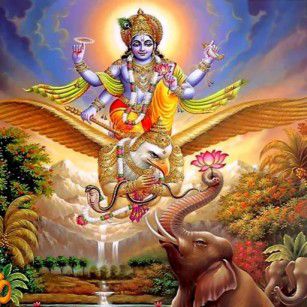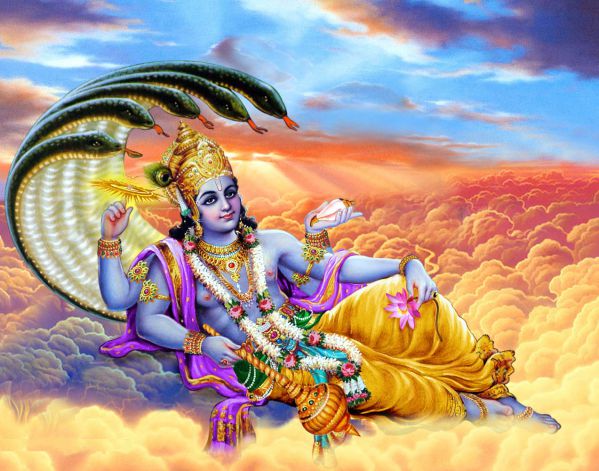No products in the cart.
Lord Vishnu – Hindu Gods and Deities
Who is Lord Vishnu?
Vishnu is a Hindu god, the Supreme God of Vaishnavism (one of the three principal denominations of Hinduism) and one of the three supreme deities (Trimurti) of Hinduism. He is also known as Narayana and Hari. As one of the five primary forms of God in the Smarta tradition, he is conceived as “the Preserver or the Protector” within the Trimurti, the Hindu Trinity of the divinity.
Vishnu is one of the most important gods in the Hindu pantheon and, along with Brahma and Shiva, is considered a member of the holy trinity (trimurti) of Hinduism. He is the most important god of Vaishnavism, the largest Hindu sect. Indeed, to illustrate Vishnu’s superior status, Brahma is, in some accounts, considered to have been born from a lotus flower which grew from Vishnu’s naval. A complex character, Vishnu is the Preserver and guardian of men (Narayana), he protects the order of things (dharma) and, when necessary, he appears on earth in various incarnations or avatars to fight demons and fierce creatures and so maintain cosmic harmony.
Vishnu represents Sattvaguna and is the centripetal force as it were, responsible for sustenance, protection and maintenance of the created universe.
Etymologically speaking, the word ‘Vishnu’ means ‘one who pervades, one who has entered into everything.’ So he is the transcendent as well the immanent reality of the universe. He is the inner cause and power by which things exist.
Lord Vishnu Family
Lord Vishnu’s consort is Goddess Lakshmi, the Goddess of Wealth.
Lord Vishnu Iconography
Vishnu resides in the milky waters of Vaikunth on a bed made of the coils of the thousand hooded great serpent, Adishesha of infinite dimensions. Goddess Lakshmi, his consort attends upon him. Symbolically the ocean stands for bliss and consciousness, the serpent for time, diversity, desire and illusion, and the goddess Lakshmi for the material things and powers of the creation.
The colour of Vishnu is the colour of a dark blue cloud. It is the colour of the sky, denoting his cosmic dimensions and his connection with the Vedic gods of rain and thunder and his relationship with the earth. He is usually depicted with one face, four arms, usually in a standing posture or in a resting posture. He wears a necklace made of the famous Kaustubha gem that rests on his left chest and another garland of flowers and gems by name Vaijayanti.
His four arms hold sankha (a conch), chakra (discus), gada (mace) and padma (lotus) respectively. The conch stands for the five elements, the sound of AUM, salagrama, goddess Lakshmi, the waters, purity and perfection. The discus is the terrible weapon of Vishnu which he used to destroy the evil and protect the righteous. It symbolically represents the light bearing sun, which illuminates and removes darkness. It also stands for higher consciousness which destroys all illusions. The mace represent the power of knowledge while the lotus symbolizes beauty, harmony, purity, water element, creation and self realization.
Garutman or Garuda, the mighty bird-vehicle of Lord Vishnu is a minor deity invariably found in all the Vaishnava temples.
Another deity invariably found in the Vishnu temples, especially in the South, is Hanuman the monkey-god. The Ramayana pictures him as a highly erudite, cultured and refined person. He is as strong as he is wise, and as devoted as he is strong and wise, a rare combination indeed.
Lord Vishnu Mantra
“Om Namo Narayanaya. Om Namo Bhagavate Vasudevaya”
(ॐ नमोः नारायणाय. ॐ नमोः भगवते वासुदेवाय)
Lord Vishnu Avatars – Dashavatar
Following is an overview of the 10 principal avatars of Vishnu:
- First incarnation of Vishnu : Matsya or the Fish incarnation : in this form Vishnu saved the Saint Vaivaswata, the hindu variety of the biblical Noah (or vice versa).
- Second incarnation of Vishnu : Kurma or the Turtle incarnation : at the Churning of the Ocean, Vishnu as Koorma (or Kurma) offered his back as a pivot on which to rest the Mount Mandara, used as a churning stick by gods and demons. More information also on the Kurma page.
- Third incarnation of Vishnu : Varaha or the Boar incarnation of Vishnu : he killed the demon Hiranyaksha, recovered the stolen Veda’s and released the Earth from the bottom of the ocean.
- Fourth incarnation of Vishnu : Narasingha or the Lion incarnation : as a creature who was half-lion and half-man, Vishnu killed the demon Hiranyashasipu, brother of Niranyaksha, who had gained the boon of immunity from attacks by man, beast or god.
- Fifth incarnation of Vishnu : Vamana or the Dwarf incarnation : he killed the demon Bali, who had gained dominion over the Earth and had chased the gods from the heavens. More can be read on the Vamana page.
- Sixth incarnation of Vishnu : Parasurama : he killed the King Kartavirya, who had stolen the holy cow Kamadhenu, which could grant all desires.
- Seventh incarnation of Vishnu : Ram : he killed the demon King Ravana, who had abducted Sita. More on Ram can be read on the Ramayana page.
- Eigth incarnation of Vishnu : Krishna : he killed Kansa, son of a demon and the tyrannical King of Mathura. More on Krishna can be read in the Life of Krishna.
- Ninth incarnation of Vishnu : Buddha : Vishnu incarnated to remove suffering from the world. More on Buddha can be read on the Buddha page. While some Hindus may oppose to seeing Buddha as a Vishnu incarnation, many other Hindus in fact embrace Buddha as such and worship Buddha both in Buddhist temples as in Hindu temples.
- Tenth Incarnation of Vishnu : Kalki : still to come at the end of the Kaliyuga or the present age of decline, when Vishnu will appear in person on Earth, seated on a white horse, Kalki, which is his tenth incarnation.
Other Lord Vishnu Avatars
These are gods who descended into this world for a specific task and with an aspect of Lord Vishnu. Mention may be made of Dattatreya, Kapila, Dhanvantari, Mohini, Hayagriva, Naranarayana, Vedavyasa and Yajna.
Lord Vishnu Temples
Lord Vishnu is one of the widely worshiped gods in India. In Hinduism, Vishnu is one of the five primary gods. In Hinduism Vishnu is worshiped as Preserver of the universe. He is married to Lakshmi, goddess of wealth. Every time mankind faced a threat from demon, an incarnation of Lord Vishnu came to earth to save humanity. Today some of the grandest and wealthiest temples in India are dedicated to Lord Vishnu or his incarnations. Here are some must visit temples of Lord Vishnu in India.
Badrinath Temple
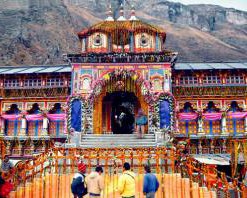 The most important temple of Lord Vishnu is Badrinath temple. It is also most important of four char dham yatra destinations. It is believed that idol of Lord Vishnu inside the temple was found by Adi Shankara in the Alaknanda river. He had a dream in which Lord Vishnu directed him to dive in the river and recover the idol. Since them, Badrinath, a hill station in Uttarakhand has become an important pilgrimage spot. During the summer months, when the gates of temple are opened, millions of devotees flock to Badrinath. It is also believed that Badrinath is permanent residence of Lord Vishnu.
The most important temple of Lord Vishnu is Badrinath temple. It is also most important of four char dham yatra destinations. It is believed that idol of Lord Vishnu inside the temple was found by Adi Shankara in the Alaknanda river. He had a dream in which Lord Vishnu directed him to dive in the river and recover the idol. Since them, Badrinath, a hill station in Uttarakhand has become an important pilgrimage spot. During the summer months, when the gates of temple are opened, millions of devotees flock to Badrinath. It is also believed that Badrinath is permanent residence of Lord Vishnu.
Jagannath Puri Temple
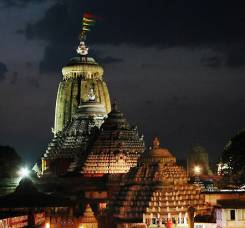 Similarly to Badrinath, Puri is also a char dham destination. The main temple here is dedicated to Lord Krishna who is an incarnation of Lord Vishnu. Lord Jagannath Puri temple is one of the holiest temples in India. It was built some 1500 years ago. Even today it does not allow non Hindus to enter the main hall of the temple. Despite that thousands of non Hindus travel Puri just to see amazing architecture of the temple from outside. The best time to visit Puri is the cooler months of October to March. However devotees should also consider the months of June and July when annual rath yatra takes place in Puri. It is one of the biggest religious events in the world.
Similarly to Badrinath, Puri is also a char dham destination. The main temple here is dedicated to Lord Krishna who is an incarnation of Lord Vishnu. Lord Jagannath Puri temple is one of the holiest temples in India. It was built some 1500 years ago. Even today it does not allow non Hindus to enter the main hall of the temple. Despite that thousands of non Hindus travel Puri just to see amazing architecture of the temple from outside. The best time to visit Puri is the cooler months of October to March. However devotees should also consider the months of June and July when annual rath yatra takes place in Puri. It is one of the biggest religious events in the world.
Dwarkadhish Temple
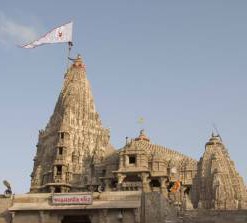 Interestingly, Dwarka too is part of char dham yatra. Three out of four temples mentioned in the holy char dham yatra are dedicated to Lord Vishnu. Dwarka is a coastal city in Gujarat. It is believed to be built by none other than Lord Krishna. The Dwarkadhish temple is dedicated to Lord Krishna and it was built by his great grandson. Although over the years the temple went through major renovation by Kings in the region. Make sure you include a visit to Dwarkadhish temple. The best time perhaps is around Janamashtmi which takes place either in August or September.
Interestingly, Dwarka too is part of char dham yatra. Three out of four temples mentioned in the holy char dham yatra are dedicated to Lord Vishnu. Dwarka is a coastal city in Gujarat. It is believed to be built by none other than Lord Krishna. The Dwarkadhish temple is dedicated to Lord Krishna and it was built by his great grandson. Although over the years the temple went through major renovation by Kings in the region. Make sure you include a visit to Dwarkadhish temple. The best time perhaps is around Janamashtmi which takes place either in August or September.
Kesava Deo Temple
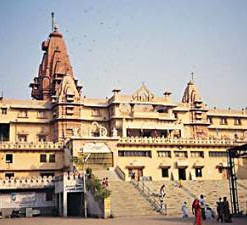 This temple is built on one of the most sacred sites for Hindus in India. The Kesava Deo Temple also known as Krishna Janmasthan is built exactly on the prison where Lord Krishna was born. It is believed that the first temple was built around 5000 years ago by great grandson of Lord Krishna. Over the years Muslims destroyed the temple several times. Last time around Aurangzeb destroyed the sacred Hindu temple in 1670 and a mosque was built. However in 1965, the temple was once again constructed but was forced to share the space with a mosque. The temple is located in the holy city of Mathura in Uttar Pradesh.
This temple is built on one of the most sacred sites for Hindus in India. The Kesava Deo Temple also known as Krishna Janmasthan is built exactly on the prison where Lord Krishna was born. It is believed that the first temple was built around 5000 years ago by great grandson of Lord Krishna. Over the years Muslims destroyed the temple several times. Last time around Aurangzeb destroyed the sacred Hindu temple in 1670 and a mosque was built. However in 1965, the temple was once again constructed but was forced to share the space with a mosque. The temple is located in the holy city of Mathura in Uttar Pradesh.
Tirumala Venkateswara Temple
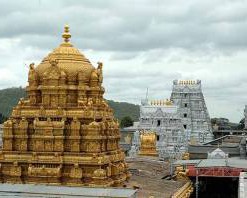 Also known as Tirupati Balaji is one of the most popular Lord Vishnu temples in India. At present it is second richest temple in the world. The temple is dedicated to Lord Venkateswara which is a form of Vishnu. The name Venkateswara means Lord who destroys the sins of people. It is believed that Lord Venkateswara will remain in this temple till the end of Kali Yuga. Around 75,000 devotees visit the temple every day. It is the most visited temple in the world. Tirumala Venkateswara Temple is located near Tirupati in Andhra Pradesh.
Also known as Tirupati Balaji is one of the most popular Lord Vishnu temples in India. At present it is second richest temple in the world. The temple is dedicated to Lord Venkateswara which is a form of Vishnu. The name Venkateswara means Lord who destroys the sins of people. It is believed that Lord Venkateswara will remain in this temple till the end of Kali Yuga. Around 75,000 devotees visit the temple every day. It is the most visited temple in the world. Tirumala Venkateswara Temple is located near Tirupati in Andhra Pradesh.
Lord Vishnu Festival and Vrats
Several Festivals are celebrated in glory of the Lord Vishnu in all parts of the country, these are held to celebrate the many trimphs of the Lord.
- Chaturmasa
Vishnu rests on Anant- Sesha the four rainy months every year. This period is known as Chaturmasa the time of social dormancy when journeys are not undertaken and marriages are not solemnized. People stay at home and pray because the sun is on its inauspious southern course, the dakshinayana making the nights longer and days colder.
The divine retreat begins on Shayani-ekadashi, the eleventh day of the waxing moon in the month of Ashadha and ends the four months. On the eleventh day of the waxing moon in the month of Kartika, Prabodhini- ekadashi.
- Diwali
The new moon night that comes after Dussera ushers in the festival of lights “Deepavali” or Diwali.
On the new moon night Lakshmi the consort Lord Visnu is worshipped by all. Lamps are lit and sacred symbols are drawn on the floors to welcome her into our homes. Diwali also commemorates the return of Shri Rama to the kingdom of Ayodhaya after 14 years in the forest. Hence devotees express their joy by lighting lamps and bursting crackers to mark the end of Chaturmasa and to herald the return of Vishnu to drive away the demons and all evil.
- Gokul-Ashtami
This festival commemorates the auspious descent of Vishnu upon this earth as Krishna. It is celebrated in the dark half of the lunar month, on the eight day of the waning moon of Shravana. This festival is celebrated late at night. Laddo gopal are placed in cradles in temples. The Lord is adorned with new poshaks, jewellery and flowers. The tale of his descent is read out from the Bhagwat Puran and the devootes in large numbers gather and listen to the parvachan and sing bhajans in his praise. Then maha prasad is distributed.
- Tulsi-Vivaha
When Vishnu rises after his four month repose, he renews his pact of protecting the earth by ceremonially marrying the earth-goddess on the twelfth day of the waxing moon in the month of Kartika.
The goddess represented by the Tulsi plant is wedded to the Lord who is represented by his idol or a shalagrama stone or a cane of sugar. This Tulsi- vivaha marks the beginning of the Hindu marriage season.
- Akshaya- Tritiya
On the third day of the bright half of Vaishaka, Renuka gave birth to Parashurama, the sixth incarnation of Lord Vishnu. On this holy day, people buy gold, safe with the knowledge that the lord will protect their wealth from thieves just as he stopped the thousand armed Kartaviryarjuna from stealing the cow Kamadhenu from the hermitage of sage Jamadagni.
- Makara- Sankranti
The shortest day of the year is 22nd December after which the sun begins its northward journey known as the Uttarayana. On the 14th of Janauary each year the Sun God, Surya- Narayana rides his golden chariot into the house of Makara, the abode of Madana the lord of love. It is a very auspious day and is known as Makara-Sankranti and also marks the winter harvest celebrated as Lohri in North India and Pongal in the South of India.
- Holi
Phalguna marks the end of winter and beginning of Spring . It is a festival of love, joy, colours and excitement welcoming the Lord of pleasure Madana who is the son of Lakshmi and Vishnu. It is a joyous festival and was the favourite festival of Krishna and Radha. On the eve of Holi great bonfires are lit to mark the end of the female demon Holika who got burnt herself while trying to burn and kill “PRAHALADA” the devotee of Vishnu- Narasimha.
- Datta Jayanti
Dattatreya Jayanti is in the month of Margashisha on the full moon day marks the day when Datta the great yogi and tantric was born to the chaste Anasuya wife of the sage Atri. Datta embodies the spirit of Vishnu and is worshipped as a Divine Teacher.
- Narali Poornima
On the full moon night in the month of Shravana fishermen throw coconuts in the sea thanking the Sea God ‘Varuna’ for holding aloft the bridge that enabled Rama to go Lanka to rescue his wife Sita from the clutches of the evil king Ravan. This day also marks the retreat of monsoon which enables the fishermen to return to the sea.
In some parts of India oxen are worshipped to celebrate the birth of Balrama, Krishna’s elder brother who is the lord of farmers. On this day sisters tie a sacred thread on the wrist of their brothers and seek their
- Dev Diwali
The full moon day that follow’s the day of Tulsi’s marriage is called Dev- Diwali, to commemorate this day the Lord descended upon eath as Matsya, the divine fish who saved the children of the earth, animals and plants from the cosmic deluge.
- Nag Pachami
Nag Panchami is celebrated on the fifth day of the waxing moon of the month of Shravana during which cobras are offered milk and worshipped as representatives of Ananta-Sesha the cosmic serpent, keeper of the earth’s fertility and destroyer of pests.
- Ram Navami
This festival celebrates the birth of Seventh Avatar of Lord Vishnu and the hero of the Ramayana, the Sanskrit epic of 24,000 stanzas, Shri Rama who was born on the 9th day of Chaitra month. Shri Ramchandra killed the evil king Ravana. A continuous recital of the book takes place for about a week prior to the celebration and on the day itself, the highlights of the story are read in the temple.
- Perumal Tirumala
Perumal Tirumala is a festival in honour of Lord Vishnu celebrated by the Vishnubhaktis. This festival lasts for eleven days or longer. In the first two days the idols of Lord Vishnu and his companions are carried about in the streets with great pomp in a palanquin. On the third day he is carried on his vehicle Garuda. On the fourth Vishnu is carried on the monkey Hanuman, on the fifth day He is carried on a lion, the sixth under a small arch or bow of metal called Tiruvasi, on the seventh under a large Tiruvasi, on the eighth on a horse and on the ninth in a large car. On the last day, the tenth day, which is the great day of the feast, Vishnu is for the last time carried about early in the morning. In the evening of the eleventh day, which is called Dhar-ba-tirumal, he and his consort Lakshmi are seated on a couch of Dharba-grass, placed on a aft in a tank and Brahmans, musicians and dancing girls, having entered on the same raft, it is floated from one end of the tank to the other, thrice, in the sight of a multitude of people standing on the banks.


